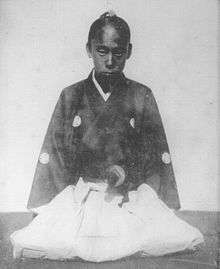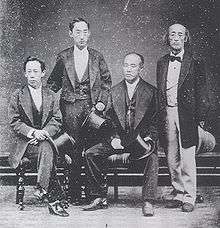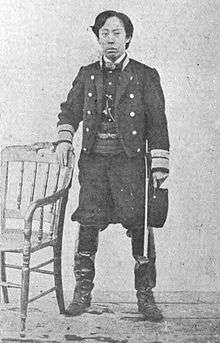Matsudaira Sadaaki
Matsudaira Sadaaki (松平 定敬, January 18, 1847 – July 12, 1908) was a Japanese daimyō of the Bakumatsu period, who was the last ruler of the Kuwana Domain. Sadaaki was the adopted heir of Matsudaira Sadamichi, the descendant of Sadatsuna, the third son of Hisamatsu Sadakatsu (1569–1623), who was Tokugawa Ieyasu's brother. His family was known as the Hisamatsu Matsudaira clan. It was to this family that Matsudaira Sadanobu also belonged.[1]
Matsudaira Sadaaki | |
|---|---|
 A young Matsudaira Sadaaki | |
| 4th (Matsudaira) Daimyō of Kuwana | |
| In office 1859–1868 | |
| Preceded by | Matsudaira Sadamichi |
| Succeeded by | Matsudaira Sadanori |
| 56th Kyoto Shoshidai | |
| In office 1864–1867 | |
| Preceded by | Inaba Masakuni |
| Succeeded by | none |
| Personal details | |
| Born | January 18, 1847 Edo, Japan |
| Died | July 12, 1908 (aged 61) |
| Nationality | Japanese |
| Spouse(s) | Matsudaira Hatsuko |
Biography
Matsudaira Tetsunosuke (the future Sadaaki) was born at Ichigaya in Edo, the 8th son of Matsudaira Yoshitatsu, the lord of the Takasu domain. One of his older brothers was Matsudaira Katamori, who later became the lord of Aizu. In 1859, Tetsunosuke was adopted to succeed the newly deceased Matsudaira Sadamichi as lord of the Kuwana Domain. He was betrothed to Sadamichi's 3-year-old daughter Hatsu, thus formalizing the adoption. Coming of age, he took the name Sadaaki.
Sadaaki was the Tokugawa shogunate's last Kyoto shoshidai in the period spanning May 16, 1864, through January 3, 1868.[2] As shoshidai, he supported his brother's work in Kyoto as the Kyoto protector. In 1864, Sadaaki deployed Kuwana troops as part of the shogunate's effort to subdue the Tengu-tō's uprising.
During these years Sadaaki was famous as an avid horseman, and received an imported Arabian horse as a gift from the Shogunate.

Sadaaki fought in the Boshin War (1868-1869), leading Kuwana forces during the fighting in northern Japan. He was together with Katamori until the start of the siege of Aizu, when Katamori asked him to leave and seek reinforcements from the other clans of the Northern Alliance.[3] Sadaaki followed his brother's advice and headed for the Yonezawa Domain.[3] After the fall of Yonezawa and the defeat of the Alliance, Sadaaki embarked on Enomoto Takeaki's warships at Matsushima Bay, and went on to the Ezo Republic.[4] He was brought to Yokohama at the war's end, where he formally surrendered. After a few years in confinement, he was pardoned and released in 1872. It was soon after his release that he finally married Matsudaira Hatsu, who had just turned 16.

Sadaaki joined the Imperial Japanese Army during the Satsuma Rebellion, leading a group of former Kuwana samurai and heading for Kyūshū. Later in life, he served as one of the head priests of Tōshōgū Shrine, along with his brother Katamori, and his brother's former chief karō, Saigō Tanomo. He also lived in Tokyo for some time, and had an avid interest in music; Clara Whitney, an American resident of Tokyo, notes in her diary that he was a skilled organ player.
Sadaaki and Hatsu had two children, Toshi and Masao, both of whom died in infancy. However, Sadaaki also had a concubine; it was this concubine who bore him a son (Sadaharu) who survived to adulthood. He also had a daughter by another woman; this daughter married Sakai Tadakazu.
Sadaaki died at age 61, and is buried in the Somei Cemetery in Tokyo.
Cultural references
Matsudaira Sadaaki has appeared as a character in many works of fiction, usually in works about his brother and Aizu. In the 1987 TV miniseries Byakkotai, he was portrayed by Hashinosuke Nakamura.[5] In NHK's 1998 Taiga drama Tokugawa Yoshinobu, Jō Watanabe portrayed him.[5] He also appears briefly in episode 7 of the anime Clockwork Fighters, Hiwou's war.
Notes
- Papinot, Edmond. (2003). Nobiliare du Japon – Matsudaira (Hisamatsu), p. 32; Papinot, Jacques Edmond Joseph. (1906). Dictionnaire d’histoire et de géographie du Japon. (in French/German).
- Meyer, Eva-Maria. "Gouverneure von Kyôto in der Edo-Zeit". Archived 2008-04-11 at the Wayback Machine Universität Tübingen (in German).
- Yamakawa, Kenjirō (1933). Aizu Boshin Senshi. p. 523.
- Yamakawa, p. 505.
- "Matsudaira sono ichi"
References
- Meyer, Eva-Maria. (1999). Japans Kaiserhof in de Edo-Zeit: Unter besonderer Berücksichtigung der Jahre 1846 bis 1867. Münster: Tagenbuch. ISBN 3-8258-3939-7
- Papinot, Edmond. (1906) Dictionnaire d'histoire et de géographie du japon. Tokyo: Librarie Sansaisha...Click link for digitized 1906 Nobiliaire du japon (2003)
- Sasaki Suguru. (2002). Boshin sensō: haisha no Meiji ishin. Tokyo: Chūōkōron-shinsha.
- Tsunabuchi Kenjō (1984). Matsudaira Katamori no subete. Tokyo: Shin Jinbutsu Ōraisha.
- Whitney, Clara (1979). Clara's diary: an American girl in Meiji Japan. Ed. M. William Steele and Tamiko Ichimata. Tokyo/New York: Kodansha International.
- Yamakawa Kenjirō (1933). Aizu Boshin Senshi. Tokyo: Tokyo Daigaku Shuppankai.
- (in Japanese) "Matsudaira Sadaaki" on bakusin.com (28 Feb. 2008)
- (in Japanese) "Matsudaira sono ichi" on Taiga dorama & jidaigeki tojōjinbutsu haiyaku jiten (28 February 2008)
Further reading
- --- (1998). Matsudaira Sadaaki no Subete. Tokyo: Shin Jinbutsu Ōraisha.
- Totman, Conrad (1980). Collapse of the Tokugawa Bakufu, 1862–1868. Honolulu: University of Hawai'i Press.
External links
- (in Japanese) "Matsudaira Sadaaki ga mita Kuwana wo aruku"
- (in Japanese) Pictures from the Kuwana-Matsudaira family graves at Somei Cemetery, including Sadaaki's
| Preceded by Matsudaira Sadamichi |
4th (Matsudaira) Daimyō of Kuwana 1859–1868 |
Succeeded by Matsudaira Sadanori |
| Preceded by Inaba Masakuni |
56th Kyoto Shoshidai 1864–1867 |
Succeeded by none |